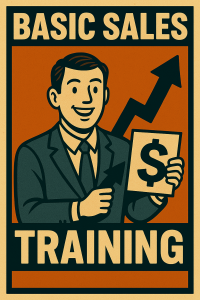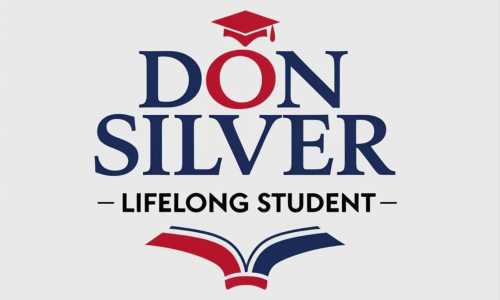Basic Sales Training for Beginners
This 8-lesson course is designed for individuals with no prior sales experience, equipping them with the foundational skills, mindset, and strategies to succeed in sales. Each lesson combines theoretical insights with practical exercises to build confidence and competence. By the end, learners will understand the sales process, handle common challenges, and feel ready to make their first sale. Lessons are structured for 45-60 minutes, including written or video content, interactive activities, and reflection tasks.

Course Objectives
- Understand the sales process from prospecting to closing.
- Build confidence in communicating with potential customers.
- Develop strategies to overcome rejection and objections.
- Apply practical sales techniques through role-playing and real-world scenarios.
- Cultivate a positive, customer-focused mindset for long-term success.
Lesson 1: What Is Sales? Shifting Your Mindset
Objective: Understand the role of sales and adopt a positive mindset toward selling.
Content:
- Define sales as a process of solving problems and creating value for customers, not “pushing” products.
- Explore common misconceptions (e.g., sales is manipulative) and reframe sales as helping others.
- Introduce the importance of confidence and resilience in sales.
Activities: - Reflection: Write down three fears or assumptions you have about sales. For each, brainstorm one way to reframe it positively (e.g., “I’m afraid of rejection” becomes “Rejection is a chance to learn”).
- Discussion: In pairs or a journal, discuss why people buy products or services.
Duration: 45 minutes
Outcome: Learners shift from fear-based to solution-focused views of sales.
Lesson 2: Understanding Your Customer
Objective: Learn to identify customer needs and motivations.
Content:
- Introduce buyer psychology: why people buy (e.g., solving problems, fulfilling desires).
- Discuss different customer types (e.g., analytical, emotional, decisive) and how to recognize them.
- Explain the importance of empathy and active listening in sales.
Activities: - Exercise: Create a “customer persona” for a product of your choice (e.g., a fitness app). Describe their needs, pain points, and motivations.
- Role-Play: Practice active listening with a partner, asking open-ended questions about their needs without pitching a product.
Duration: 50 minutes
Outcome: Learners can identify customer needs and practice empathetic communication.
Lesson 3: Finding and Connecting with Prospects
Objective: Master the art of prospecting and initiating conversations.
Content:
- Define prospecting and its role in the sales funnel.
- Explore methods to find prospects (e.g., referrals, social media, cold outreach).
- Learn how to craft a compelling initial outreach (e.g., emails, calls) that focuses on the customer’s needs.
Activities: - Exercise: Write a 3-sentence outreach email to a potential customer, focusing on their needs rather than your product.
- Role-Play: Practice a 30-second “elevator pitch” introducing yourself and your value proposition.
Duration: 50 minutes
Outcome: Learners can identify prospects and initiate conversations confidently.
Lesson 4: Building Rapport and Trust
Objective: Develop skills to build authentic relationships with customers.
Content:
- Discuss the importance of trust in sales and how to establish it (e.g., honesty, reliability, relatability).
- Explore techniques for building rapport, such as mirroring, storytelling, and finding common ground.
- Address common mistakes (e.g., being overly salesy, ignoring customer cues).
Activities: - Exercise: Write a short story about a time you solved a problem similar to a customer’s pain point.
- Role-Play: Practice building rapport in a mock sales conversation, focusing on finding common ground.
Duration: 45 minutes
Outcome: Learners can connect with customers authentically and build trust.
Lesson 5: Presenting Your Solution
Objective: Learn to pitch a product or service effectively.
Content:
- Introduce the structure of a good sales pitch: problem, solution, benefits, proof.
- Discuss how to tailor your pitch to the customer’s specific needs and motivations.
- Highlight the importance of clear, concise communication and storytelling.
Activities: - Exercise: Create a 1-minute pitch for a product or service, addressing a specific customer need.
- Role-Play: Deliver your pitch to a partner, who provides feedback on clarity and persuasiveness.
Duration: 55 minutes
Outcome: Learners can craft and deliver a compelling, customer-focused pitch.
Lesson 6: Handling Objections and Rejection
Objective: Develop strategies to address objections and cope with rejection.
Content:
- Explain common objections (e.g., price, timing, trust) and how to respond empathetically.
- Teach the “feel, felt, found” technique (e.g., “I understand how you feel, others have felt the same, but they found…”).
- Discuss how to handle rejection without taking it personally.
Activities: - Exercise: List three common objections for a product of your choice and write responses using the “feel, felt, found” method.
- Role-Play: Practice responding to objections in a mock sales scenario.
Duration: 50 minutes
Outcome: Learners can confidently address objections and maintain resilience after rejection.
Lesson 7: Closing the Sale
Objective: Master techniques for closing deals effectively.
Content:
- Define closing and its role in the sales process.
- Introduce closing techniques (e.g., assumptive close, urgency close, question close).
- Discuss how to recognize buying signals and avoid being pushy.
Activities: - Exercise: Identify three buying signals (e.g., asking about pricing) and write a closing question for each.
- Role-Play: Practice closing a sale with a partner, using one of the techniques learned.
Duration: 50 minutes
Outcome: Learners can recognize opportunities to close and apply appropriate techniques.
Lesson 8: Putting It All Together
Objective: Apply the full sales process in a real-world scenario and reflect on growth.
Content:
- Review the sales process: prospecting, rapport, pitching, objections, closing.
- Discuss how to create a personal sales plan and set goals for continued improvement.
- Encourage a growth mindset: sales skills improve with practice and reflection.
Activities: - Exercise: Create a personal sales plan, including one goal for each stage of the sales process.
- Role-Play: Conduct a full sales conversation, from prospecting to closing, with a partner or instructor.
- Reflection: Write a short paragraph on how your view of sales has changed since Lesson 1.
Duration: 60 minutes
Outcome: Learners can execute the full sales process and feel confident making their first sale.
Final Takeaway
By the end of this course, learners will transform from nervous beginners to confident salespeople who see sales as an opportunity to solve problems and build relationships. They’ll be equipped with practical tools and a resilient mindset to make their first sale and continue growing in their sales journey.
Lessons
-
Lesson 1: What Is Sales? Shifting Your Mindset
-
Lesson 2: Understanding Your Customer
-
Lesson 3: Finding and Connecting with Prospects
-
Lesson 4: Building Rapport and Trust
-
Lesson 5: Presenting Your Solution
-
Lesson 6: Handling Objections and Rejection
-
Lesson 7: Closing the Sale
-
Lesson 8: Putting It All Together

